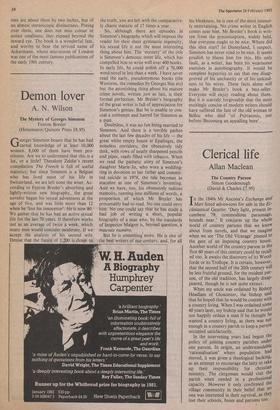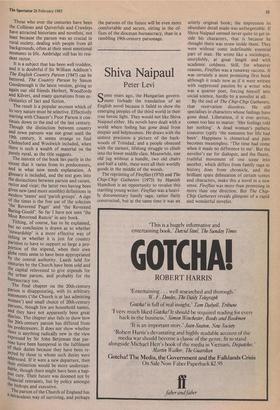Clerical life
Allan Maclean
The Country Parson Simon Goodenough (David & Charles £7.95)
In the 1840s Mr Ancona's Ex-change and Mart listed advowsons for sale in the Ec- clesiastical Gazette: 'Duty light, present in- cumbent 79, commodious parsonage, hounds near.' It conjures up the whole world of country parsons that we know about from novels, and that we imagine when we see 'The Old Vicarage' pinned to the gate of an imposing country house. Another world of the country parson in the first 60 years of this century could be recall- ed too. It awaits the discovery of its Wood- forde or its Trollope. It is certain, however, that the second half of the 20th century will be less fruitful ground, for the resident par- son, of the old tradition, has largely disap- peared, though he is not quite extinct.
When my uncle was ordained by Bishop Headlam of Gloucester, the bishop said that he hoped that he would be content with a country living. When I was ordained some 40 years later, my bishop said that he would not happily ordain a man if he thought he wanted a country living, as there was not enough in a country parish to keep a parson occupied satisfactorily. In the intervening years had begun the policy of joining country parishes under one parson. In origin, an understandable 'rationalisation' where population had moved, it was given a theological backing, as an attempt to encourage the laity to take up their responsibility for christian ministry. The clergyman would visit the parish when needed in a professional capacity. However it only confirmed the village community in their belief that 110 one was interested in their survival, as they lost their schools, buses and parsons too.
Those who over the centuries have been the Collinses and Quiverfuls and Crawleys have attracted historians and novelists, not least because the parson was so crucial in rural society, dealing with people from all backgrounds, often at their most emotional moments in life. Ambridge still has its resi- dent rector.
It is a subject that has been well trodden, and it is doubtful if Sir William Addison's The English Country Parson (1947) can be bettered. The Country Parson by Simon Goodenough is the latest version, giving us again our old friends Herbert, Woodforde and Kilvert, and many quotations from ec- clesiastics of fact and fiction.
The result is a popular account which of its very nature must be selective. Effectively starting with Chaucer's Poor Parson it con- tinues down to the end of the last century. Though the distinction between country and town parsons was not great until the 19th century, it seems strange to find Chelmsford and Woolwich included, when there is such a wealth of material on the Purely rural, as the title suggests.
The interest of the book lies partly in the extent that it varies from its predecessors, and in what now needs explanation. A glossary is included, and the text goes into the distinctions between parson and curate, rector and vicar; the latter two having been given new (and more sensible) definitions in modern 'teams' and 'parish groups'. A sign of the times is the free use of the solecism `the Reverend Paget' and 'the Reverend Baring-Gould'. So far I have not seen 'the Most Reverend Runcie' in any book.
Tithing, of course, has to be explained, but no conclusion is drawn as to whether stewardship' is a more effective way of tithing or whether it is just for country Parishes to have to support so large a pro- Portion of the stipend, when their own glebe rents seem to have been appropriated by the central authority. Lands held for centuries by the Church have been sold and the capital reinvested to give stipends for the urban parson, and probably for the bureaucracy too. The final chapter on the 20th-century Parson is disappointing, with its arbitrary statements (`the Church is at last admitting Women') and small choice of 20th-century Parsons, though few are household names, and they have not apparently been great diarists. The chapter also fails to show how the 20th-century parson has differed from his predecessors. It does not show whether there is anything radically new in the view expressed by Sir John Betjeman that par- sons have been hampered in the fulfilment of their duties because they have been re- jected by those to whom such duties were addressed. If it were a new departure, then their extinction would be more understan- dable, though there might have been a hap- Pier cure. Their future was doomed not by financial restraints, but by policy amongst the bishops and executive.
The parson of the Church of England has a miraculous way of surviving, and perhaps the parsons of the future will be even more comfortable and secure, sitting in the of- fices of the diocesan bureaucracy, than in a rambling 19th-century parsonage.











































 Previous page
Previous page